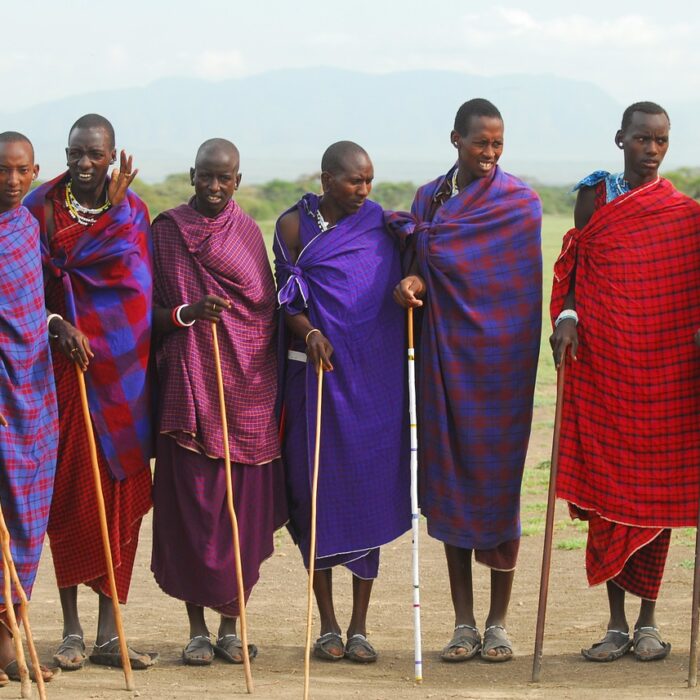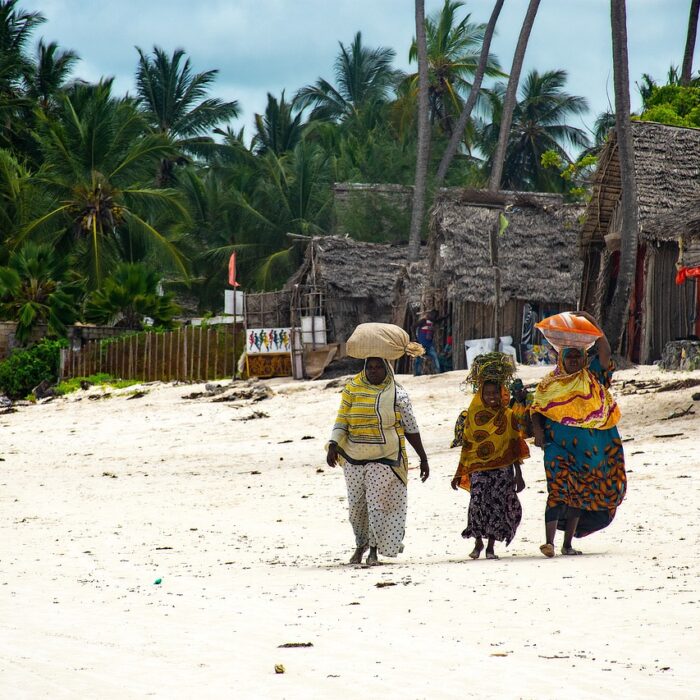.elementor-widget-text-editor.elementor-drop-cap-view-stacked .elementor-drop-cap{background-color:#69727d;color:#fff}.elementor-widget-text-editor.elementor-drop-cap-view-framed .elementor-drop-cap{color:#69727d;border:3px solid;background-color:transparent}.elementor-widget-text-editor:not(.elementor-drop-cap-view-default) .elementor-drop-cap{margin-top:8px}.elementor-widget-text-editor:not(.elementor-drop-cap-view-default) .elementor-drop-cap-letter{width:1em;height:1em}.elementor-widget-text-editor .elementor-drop-cap{float:left;text-align:center;line-height:1;font-size:50px}.elementor-widget-text-editor .elementor-drop-cap-letter{display:inline-block}
Tanzania is renowned for its rich cultural diversity. Home to over 120 ethnic groups, each with its unique traditions, languages, and customs, Tanzania presents a vibrant mosaic of cultures that have coexisted for centuries.
From the semi-nomadic Maasai warriors of the Great Rift Valley to the ancient hunter-gatherer traditions of the Hadzabe people in the Lake Eyasi region, Tanzania offers a fascinating tapestry of cultures that coexist harmoniously. This diversity is not only a source of national pride but also a significant attraction for visitors from around the world, eager to experience the unique cultural landscapes.
This guide aims to provide an insightful journey into the history, traditions, and lifestyles of some of the major tribes in Tanzania. Whether you are a student, a traveler, or simply someone with a keen interest in cultural studies, this guide will offer valuable insights into the vibrant and multifaceted world of Tanzania’s tribes.
.elementor-heading-title{padding:0;margin:0;line-height:1}.elementor-widget-heading .elementor-heading-title[class*=elementor-size-]>a{color:inherit;font-size:inherit;line-height:inherit}.elementor-widget-heading .elementor-heading-title.elementor-size-small{font-size:15px}.elementor-widget-heading .elementor-heading-title.elementor-size-medium{font-size:19px}.elementor-widget-heading .elementor-heading-title.elementor-size-large{font-size:29px}.elementor-widget-heading .elementor-heading-title.elementor-size-xl{font-size:39px}.elementor-widget-heading .elementor-heading-title.elementor-size-xxl{font-size:59px}
Major Tribes In Tanzania
There are various tribes in Tanzania, each with its own unique traditions, languages, and ways of life. They include:
1. The Maasai Tribe
The Maasai are a Nilotic ethnic group who trace their origins to the Nile Valley. They began migrating southward around the 15th century, eventually settling in the Great Rift Valley region of Kenya and Tanzania. This migration was driven by a search for fertile grazing land for their cattle, which are central to Maasai culture and economy. Over the centuries, the Maasai established themselves as dominant pastoralists in the region, known for their fierce warrior traditions and resistance to colonial encroachment.
The Maasai lead a semi-nomadic lifestyle centered around their cattle, which they regard as a symbol of wealth and social status. Their diet is primarily based on meat, milk, and blood from their livestock. Maasai homes, known as enkangs, are circular huts made from mud, sticks, grass, and cow dung, reflecting their pastoral way of life. The community is organized into clans and age sets, with boys and men progressing through various stages of life as they grow older, from childhood to warriorhood (moran) and eventually elder status. Each stage is marked by specific roles, responsibilities, and rituals that maintain the social structure and cultural continuity.
Unique Cultural Practices
The Maasai are renowned for their distinctive cultural practices, which include:
Attire and Adornments: Maasai clothing is brightly colored, often in red, and adorned with intricate beadwork. Men typically wear shukas (colorful blankets), while women wear beaded necklaces, bracelets, and earrings that signify their age and social status.
Adumu (Jumping Dance): The adumu, or jumping dance, is a traditional Maasai dance performed during celebrations and ceremonies. Young warriors (moran) participate in this dance, showcasing their strength and agility by jumping high into the air while chanting rhythmically.
Eunoto Ceremony: This ceremony marks the transition into adulthood for Maasai men, involving rituals, the painting of hair with ochre, and traditional attire.
2. The Hadzabe Tribe
The Hadzabe, often referred to as Hadza, are one of the last remaining hunter-gatherer tribes in the world. They inhabit the Lake Eyasi region in northern Tanzania and have maintained their traditional way of life for thousands of years. The Hadzabe rely on hunting games and every part of the animals they hunt is used effectively. Skins are fashioned into clothing, bones are crafted into tools, and feathers are used for arrow fletching.foraging for wild plants, fruits, and honey. Men typically hunt using handmade bows and arrows, often coated with poison, to ensure effectiveness. Women gather edible plants, tubers, and berries and also participate in the honey collection from wild bees.
The Hadzabe have a rich oral tradition and speak Hadzane, a language notable for its use of click sounds. Despite various external influences over the years, they have preserved their traditional way of life. This language is characterized by distinct clicking sounds that are integrated into their speech. It is very complex, and they use language not only for communication but also as a means to pass on their rich oral traditions, stories, and knowledge about hunting and gathering practices.
Their clothing is characterized by simplicity and practicality, made from natural materials. Animal skins are commonly used to create garments, providing durability and protection. Additionally, plant fibers are used for crafting attire. The Hadzabe also adorn themselves with beads and jewelry, where specific patterns and colors hold cultural significance, reflecting their identity and social status.
Additionally, the Hadzabe do not follow a formal religion or believe in an afterlife. Instead, they have unique spiritual practices. For instance, during hunting expeditions, they may offer prayers to Ishoko (the sun) or Haine (Ishoko’s husband) for success and protection. One of their distinctive rituals is the epeme dance, performed by men at the sight of the new moon, which is a celebration of their connection to the natural world and celestial events.
They also have a strong sense of community by sharing everything that is hunted or gathered. This communal approach reinforces their unity and cooperation, ensuring that all members of the tribe benefit from the collective efforts of the group.
3. The Chaga Tribe
The Chaga people inhabit the fertile slopes of Mount Kilimanjaro. They are known for their intensive farming techniques, which include the use of terracing to prevent soil erosion and maximize arable land on the mountain’s steep slopes. The Chaga grow a variety of crops, with bananas and coffee being the most prominent. Coffee cultivation has been a major economic activity for the Chaga since the colonial era, providing a significant source of income.
In addition to coffee and bananas, the Chaga also cultivate maize, beans, and various vegetables, ensuring food security for their communities. They practice mixed farming, which involves combining crop cultivation with livestock rearing. Livestock, including cattle, goats, and chickens, are kept for milk, meat, and manure, which is used to fertilize their fields. The Chaga’s agricultural prowess and innovative farming methods have made them one of the most prosperous ethnic groups in Tanzania.
Social Structure and Family Life
The Chaga society is organized around clans and extended family units. Each clan, known as a mtaa, consists of several related families and plays a crucial role in social and economic activities. The family unit, called a nyumba, is typically headed by the eldest male, who holds significant authority and responsibility over family affairs. Inheritance practices among the Chaga follow a patrilineal system, wherein property and land are passed down from father to son, reinforcing the continuity of family leadership and economic stability.
However, women also play essential roles in both the household and agricultural activities. The extended family system provides a support network, with members assisting each other in farming, building homes, and other communal tasks. Bridewealth, usually paid in livestock or other valuable goods, is an essential part of the marriage process, symbolizing the union of two families.
Festivals and Ceremonies
The Chaga people celebrate various festivals and ceremonies that reflect their cultural heritage and agricultural lifestyle. Some of the notable festivals and ceremonies include:
- Harvest Festivals: Celebrated to mark the end of the farming season, these festivals are occasions for the community to come together and give thanks for a bountiful harvest.
- Circumcision Ceremonies: For Chaga boys, circumcision is a crucial rite of passage into adulthood. The ceremony, known as unyago, involves a series of rituals, teachings, and celebrations that prepare the boys for their roles as men in the community.
- Spiritual and Ancestral Ceremonies: The Chaga hold ceremonies to honor their ancestors and seek their guidance and protection. These ceremonies often involve offerings of food and drink, prayers, and rituals conducted by elders or spiritual leaders.
4. The Sukuma Tribe
The Sukuma people are the largest ethnic group in Tanzania, primarily residing in the northwestern region near Lake Victoria. Their history is marked by migration and adaptation. The Sukuma are believed to have migrated from the west, possibly from the areas around the Congo Basin, and settled in the fertile plains south of Lake Victoria several centuries ago. Their migration was driven by the search for arable land and better living conditions. Over time, the Sukuma established themselves as skilled farmers and cattle herders, creating a robust and cohesive community.
During the pre-colonial period, the Sukuma organized themselves into small chiefdoms, each ruled by a chief known as an “ntemi.” These chiefdoms engaged in trade, agriculture, and livestock rearing, and they occasionally formed alliances or rivalries with neighboring ethnic groups. The arrival of European colonial powers in the late 19th century brought significant changes to the Sukuma’s political and social structures. Still, the community managed to maintain many of its traditional practices and customs.
Livelihood
Agriculture is the cornerstone of the Sukuma economy. The fertile plains of their homeland allow for the cultivation of a variety of crops, with cotton and rice being the most significant cash crops. Cotton, in particular, has been a major source of income for the Sukuma, both during the colonial era and in modern times. The cultivation of rice is also widespread, providing food security and economic stability.
In addition to crop farming, the Sukuma are known for their livestock rearing. Cattle hold a special place in Sukuma society, serving not only as a source of milk and meat but also as a measure of wealth and social status. Goats, sheep, and chickens are also commonly raised.
Fishing is another important economic activity, especially for those living near Lake Victoria. The lake provides a rich source of fish, which are consumed locally and sold in markets to generate income.
Cultural Significance of Dance and Music
Dance and music are integral to Sukuma culture, serving as expressions of identity, social cohesion, and spiritual beliefs. The Sukuma are renowned for their vibrant and dynamic traditional dances, which are performed during various ceremonies and festivals. These dances often involve elaborate costumes, masks, and props, and they are accompanied by rhythmic drumming and singing.
One of the most famous Sukuma dances is the “Bugobogobo” dance, which is performed during celebrations and special occasions. This dance is characterized by its energetic movements, acrobatic displays, and intricate choreography. It is not only a form of entertainment but also a way to preserve and transmit cultural values and stories.
5. The Makonde Tribe
The Makonde people, primarily residing in the Mtwara region of southern Tanzania and northern Mozambique, are renowned for their exceptional wood carving skills. The Makonde carve intricate and expressive sculptures from hardwoods such as ebony and mahogany.
One of the most distinctive forms of Makonde art is the “ujamaa” (family tree) sculpture, which represents interwoven human figures symbolizing unity, strength, and community. Another prominent style is the “shetani” (spirit) carving, characterized by its surreal and imaginative forms representing spirits and mythological beings. The Makonde’s carving tradition is passed down through generations, with skills and techniques taught from master carvers to apprentices.
The Makonde society is organized around clans, with each clan consisting of extended families connected by common ancestry. This clan system forms the basis of social structure and governance, with clan elders playing significant roles in decision-making and conflict resolution. The Makonde practice a matrilineal system of inheritance, where lineage and property are traced through the mother’s side. This matrilineal tradition emphasizes the importance of women in social and economic affairs, granting them considerable influence within the community.
Rituals and ceremonies are central to Makonde culture, marking important life stages and communal events. One of the most significant rituals is the initiation ceremony for boys and girls, known as “Lando” and “unyago.” These initiation rites involve elaborate rituals, teachings, and physical challenges that prepare the youth for adulthood and their roles in society. The ceremonies include symbolic acts, such as circumcision for boys and the seclusion of girls, followed by celebrations featuring dance, music, and feasting.
6. The Datooga
The Datooga people, also known as Tatoga, are an ethnic group primarily residing in the central and northern regions of Tanzania. Their history is marked by migration and adaptation, similar to many other ethnic groups in East Africa. The Datooga are believed to have migrated from the western highlands of Ethiopia, eventually settling in the regions surrounding Lake Eyasi and the Great Rift Valley. Over centuries, they have established themselves as pastoralists and agro-pastoralist.
The Datooga’s primary economic activities revolve around pastoralism and agro-pastoralism. Cattle herding is central to their livelihood, providing milk, meat, and hides and serving as a measure of wealth and social status. In addition to cattle, the Datooga also raises goats, sheep, and donkeys. The management of livestock involves seasonal migrations to find water and pasture, demonstrating their adaptability to the region’s climatic conditions.
Agriculture is also an essential part of the Datooga economy. They cultivate crops such as maize, millet, sorghum, and beans, often practicing mixed farming to ensure food security. The Datooga’s agricultural practices are characterized by their knowledge of the land and sustainable farming techniques, which help them maintain soil fertility and crop yields.
The Datooga also engages in artisanal crafts, producing items such as beadwork, pottery, and metalwork. These crafts not only provide additional income but also hold cultural significance, often used in ceremonies and as markers of social identity.
The Datooga places a strong emphasis on the roles and responsibilities of different age groups. Children are raised with a sense of community, learning traditional skills and values from their elders. Gender roles are clearly defined, with men primarily responsible for herding and protecting the livestock, while women manage the household and engage in farming and crafting activities.
7. The Hehe Tribe
The Hehe people are an ethnic group residing primarily in the Iringa Region of southern Tanzania. They trace their origins to the Bantu migrations, which brought them to the region centuries ago. Over time, the Hehe established themselves as a powerful and cohesive community known for their organizational skills and military prowess.
In the 19th century, under the leadership of Chief Mkwawa, the Hehe fiercely resisted German colonial forces. Chief Mkwawa’s strategic insight and the Hehe warriors’ formidable resistance became legendary, culminating in the Battle of Lugalo in 1891, where the Hehe achieved a significant victory. Despite the eventual defeat and the capture of Mkwawa’s head by the Germans, the Hehe resistance remains a proud symbol of their resilience and bravery.
Livelihood and Economic Activities
The Hehe economy is primarily based on agriculture, with farming being the mainstay of their livelihood. They cultivate various crops, including maize, millet, beans, cassava, and sweet potatoes. The fertile highlands of the Iringa region provide favorable conditions for these crops, ensuring food security for the Hehe communities.
In addition to crop farming, the Hehe also engages in livestock rearing and keeping cattle, goats, and sheep. Livestock are not only a source of food but also serve as a measure of wealth and social status. The Hehe practices mixed farming, integrating crop cultivation with livestock management to maintain a balanced and sustainable agricultural system.
Trade is another important economic activity for the Hehe. Local markets are vibrant hubs where agricultural produce, livestock, and artisanal goods are exchanged. The Hehe are known for their craftsmanship, producing items such as pottery, baskets, and woven textiles, which are sold in local and regional markets.
The Hehe society is organized into clans, each with its lineage and traditions. The clan system is the foundation of social structure and governance, with clan elders holding significant authority and responsibility. The Hehe practice a patrilineal system of inheritance, where property and lineage are traced through the male line.
One notable traditional dance is the “Mganda” dance, performed by men and women during festive occasions. This dance involves coordinated movements, rhythmic drumming, and singing, symbolizing unity and communal harmony. The “Ving’weng’we” dance is another significant cultural expression, often performed during rituals to honor ancestors and seek their blessings.
8. The Iraqw Tribe
The Iraqw people, also known as Wambulu, are an ethnic group primarily residing in the Manyara and Arusha regions of northern Tanzania. Their origins are traced back to the Cushitic-speaking peoples of the Horn of Africa. The Iraqw are part of the larger Cushitic migration that took place thousands of years ago, leading them to settle in the fertile highlands and rift valleys of present-day Tanzania. Over time, the Iraqw developed a distinct culture and identity, influenced by their interactions with neighboring ethnic groups such as the Hadzabe, Datoga, and Maasai.
They cultivate various crops, including maize, beans, millet, sorghum, and coffee. The fertile volcanic soil of the region supports their agricultural activities, ensuring good yields and food security. Terracing is a notable feature of Iraqw agriculture. The Iraqw construct terraces on the hilly terrain to prevent soil erosion and maximize arable land. Music among the Iraqw is closely tied to their oral traditions, used to convey stories, history, and moral lessons. Songs are performed during communal gatherings, rituals, and daily activities, providing a soundtrack to their way of life. The Iraqw’s musical heritage reflects their connection to nature, ancestors, and community values.
One notable traditional dance is the “Guyo” dance, performed by men and women during festive occasions. This dance involves coordinated movements, rhythmic drumming, and singing, symbolizing unity and communal harmony. The “Matambiko” dance is another significant cultural expression, often performed during rituals to honor ancestors and seek their blessings.
Iraqw society is structured around tightly-knit communities where family and social cohesion are paramount. These communities function on strong interdependence, with social activities and responsibilities shared among members. The importance of family is reflected in their communal living arrangements and collective efforts in farming and other daily tasks. Social gatherings, festivals, and ceremonies further strengthen these bonds, playing a crucial role in maintaining cultural traditions and unity.
Their language, Iraqw, is part of the Cushitic branch of the Afro-Asiatic language family. It serves as a vital link to their cultural heritage and identity, with oral traditions and stories passed down through generations in this native tongue. The preservation of the Iraqw language is essential for maintaining their rich cultural history and unique worldview.
Architecture
The Iraqw are also renowned for their unique architecture, particularly their underground houses, known as “Nyumba ya Chini.” These ingenious structures are designed to protect against the region’s harsh weather conditions and wild animals. The underground houses are built by excavating the earth to create a sunken living space, which is then covered with a thatched roof. This design provides natural insulation, keeping the interior cool during the hot seasons and warm during the cooler periods.
The construction of “Nyumba ya Chini” is a communal effort, reflecting the Iraqw’s emphasis on cooperation and social cohesion. These houses are not only practical but also symbolize the Iraqw’s deep connection to their land and environment. By living in harmony with nature, the Iraqw demonstrate resilience and adaptability, preserving their way of life in a challenging landscape.
Conclusion
Understanding the tribes of Tanzania offers a profound insight into the country’s rich tapestry of history, traditions, and lifestyles. Each tribe, from the pastoral Maasai to the agricultural Hehe, contributes uniquely to the nation’s cultural mosaic, embodying centuries of heritage and resilience. Recognizing and appreciating these diverse cultures fosters greater respect and unity, highlighting the shared values and distinct identities that make Tanzania so unique.
Learning more about and engaging with local cultures is not only enriching but also essential for preserving these traditions for future generations. Whether through participating in cultural festivals, visiting local markets, or engaging in community projects, there are numerous ways to connect with and support Tanzanian tribes. These interactions deepen our understanding and appreciation of their customs and lifestyles, reinforcing the importance of cultural preservation in an ever-globalizing world.
FAQs on About Tribes in Tanzania
What is the significance of circumcision among Tanzanian tribes?
Circumcision holds significant cultural and social importance among many tribes in Tanzania. It is often seen as a rite of passage marking the transition from boyhood to manhood. The practice is deeply rooted in tradition and is accompanied by ceremonies and rituals that vary from tribe to tribe.
What is the oldest tribe in Tanzania?
The Datoga tribe considers themselves to be the oldest tribe in Tanzania, though other tribes like the Maasai and the Bushmen also make this claim. The Datoga are known for their self-reliance and pride, and they have a reputation as fierce warriors with exceptional stealth abilities.
Which Tribe is the Biggest in Tanzania?
The Sukuma tribe is the largest ethnic group in Tanzania, constituting nearly 13% of the total population. In contrast, the remaining large ethnic groups each represent less than 5% of the population. The distribution of ethnic groups in Tanzania often reflects geographical regions, with the Sukuma predominantly residing in the northwestern part of the country.
The post A Guide to the Tribes in Tanzania: History, Traditions, and Lifestyle appeared first on Luxury Tanzania Safaris | Sababu Safaris.








